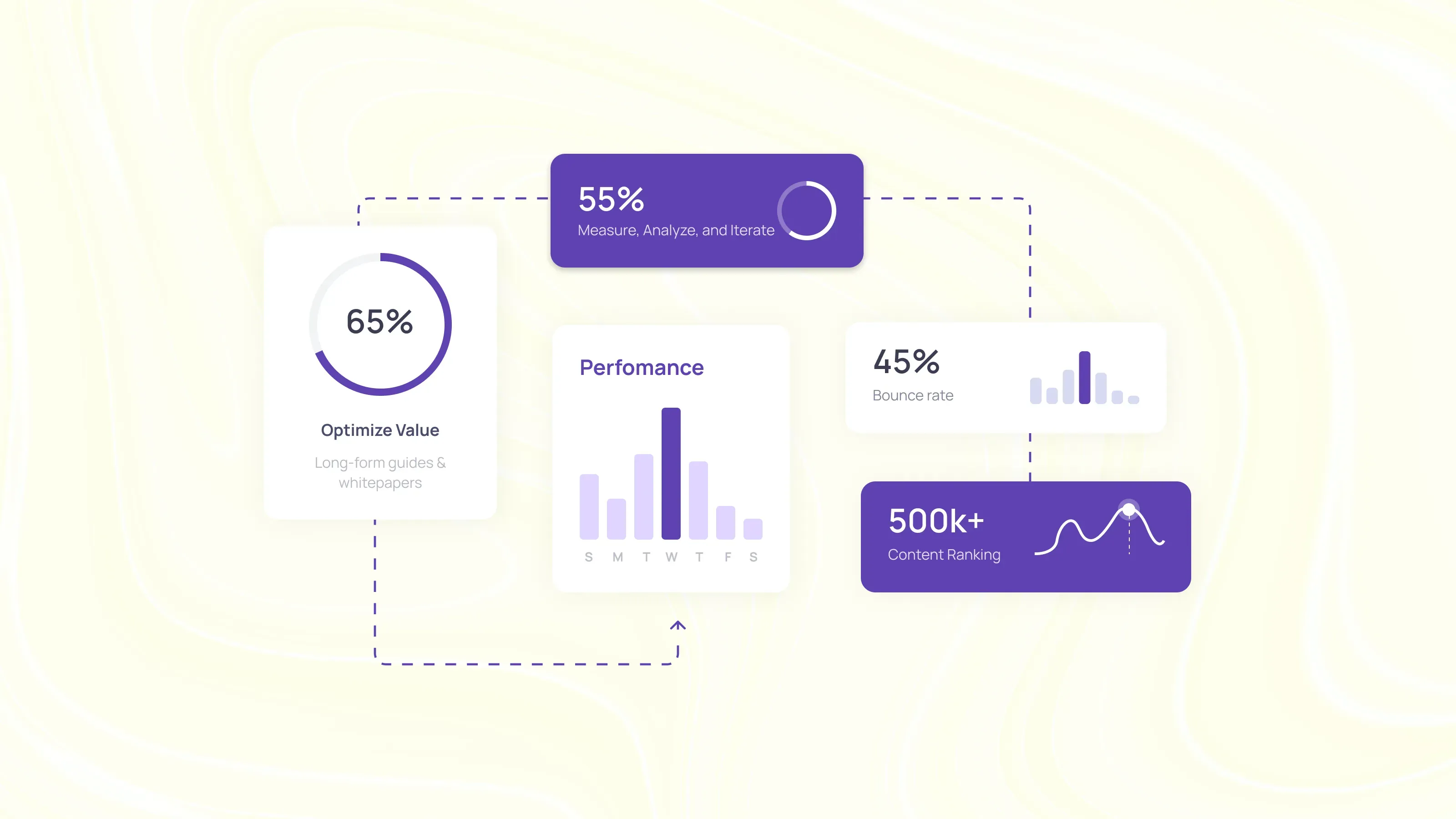Overview
This blog walks you through a five-step content marketing strategy designed to grow your business. From defining your target audience and auditing existing content to building SEO-friendly pillar–cluster structures, creating high-value assets, and tracking performance metrics - you’ll get a practical framework to generate traffic, improve visibility, and increase sales.
Step 1: Define Your Audience and Goals
Before you write a single word, clarify:
- Who you’re targeting (buyer personas)
- What outcomes you need (e.g., MQLs, demo requests)
- Which channels matter most (blog, LinkedIn, newsletters)
Why it works: HubSpot found that companies with documented personas see 171% more revenue growth than those without.
Use Snoika’s SEO Optimization suite to analyze your site’s visitor demographics and uncover high-value segments in seconds.
Step 2: Audit Existing Content and Identify Gaps

A comprehensive content audit reveals:
- Top performers - what’s driving traffic and conversions
- Underperformers - content to refresh or retire
- Topic gaps - areas your audience is searching for but you haven’t covered
Why it works: According to Content Marketing Institute, 65% of marketers say a content audit unlocks opportunities for higher ROI.
Run Snoika’s site crawler to generate an audit report in minutes, then map your existing pieces to a topic-cluster framework for maximum SEO impact.
Step 3: Develop a Content Plan with Pillar Pages and Clusters
Organize your topics into:
- Pillar pages - in-depth cornerstone articles (2,000+ words)
- Cluster posts - shorter, supporting pieces that link back to the pillar
Why it works: Moz reports that this pillar–cluster model boosts topical authority and can increase organic rankings by up to 50%.
Use Snoika’s AI-assisted outlining tool - part of our Website Builder & SEO suite - to automatically generate a cluster map and suggested internal links.
Step 4: Create and Optimize High-Value Assets
Choose formats that resonate with your audience and support SEO and traffic generation goals:
- Long-form guides & whitepapers – Backlinko data shows these earn 3× more backlinks on average.
- Interactive tools & quizzes – interactive content can boost engagement by 50%.
- Case studies - real-world proof accelerates trust and decision-making.
Leverage Snoika’s AI copy suggestions and SEO scoring to optimize headlines, meta descriptions, and readability before you hit “Publish.” Well-structured content not only converts better but also supports long-term traffic generation.
Step 5: Measure, Analyze, and Iterate
Track these content performance metrics:
- Organic sessions per asset (visibility)
- Average time on page & scroll depth (engagement)
- Conversion rate & MQLs generated (pipeline impact)
- Bounce rate & returning visitor percentage (content relevance)
Why it works: HubSpot’s guide to A/B testing shows that iterating on headlines and CTAs can boost conversions by up to 49%, while Ahrefs data on engagement metrics reveals top-ranking content enjoys 10× higher dwell time than lower-rankers.
Use Snoika’s unified analytics dashboard to set real-time alerts on these KPIs -when a drop in organic sessions or a spike in bounce rate occurs, refresh your headlines, swap in new visuals or interactive elements, and re-promote the asset. Embedding this feedback loop into your content marketing strategy ensures every update drives more traffic and conversions.
Benefits of a 5-Step Content Strategy
Tracking outcomes is crucial. While impressions and clicks are a start, more refined content performance metrics -like conversions, time on page, and bounce rate - reveal whether your content is hitting the mark.
- Ask: “How long are readers staying on each page?”
- Check your email click-through rates if email marketing is part of your strategy.
- Assess which blog posts generate the most comments and shares.
Monitoring and optimizing your results is an ongoing task; for more robust data tracking and actionable insights, consider The Best Marketing Tool Success for your Business.
How to Put Your Content Strategy Into Action
Having a plan is one thing - executing it effectively is another. To turn your strategy into measurable growth, focus on:
-
Prioritization: Start with high-impact assets (pillar pages, case studies, interactive tools).
-
Consistency: Commit to a publishing cadence that keeps your audience engaged.
-
Integration: Align content with sales, product, and customer success teams for maximum impact.
-
Promotion: Distribute across SEO, social, and email to extend reach.
Pro tip: Use Snoika to plan, publish, and track your content strategy in one place.
Conclusion
By following these five steps - defining your audience, auditing content, structuring pillar–cluster programs, creating optimized assets, and iterating based on content performance metrics - you’ll build a content marketing strategy that sustainably drives both traffic and sales. Ready to supercharge your efforts? Explore more best practices in our SEO Optimization guide and let Snoika’s AI do the heavy lifting, so you can focus on growth.







